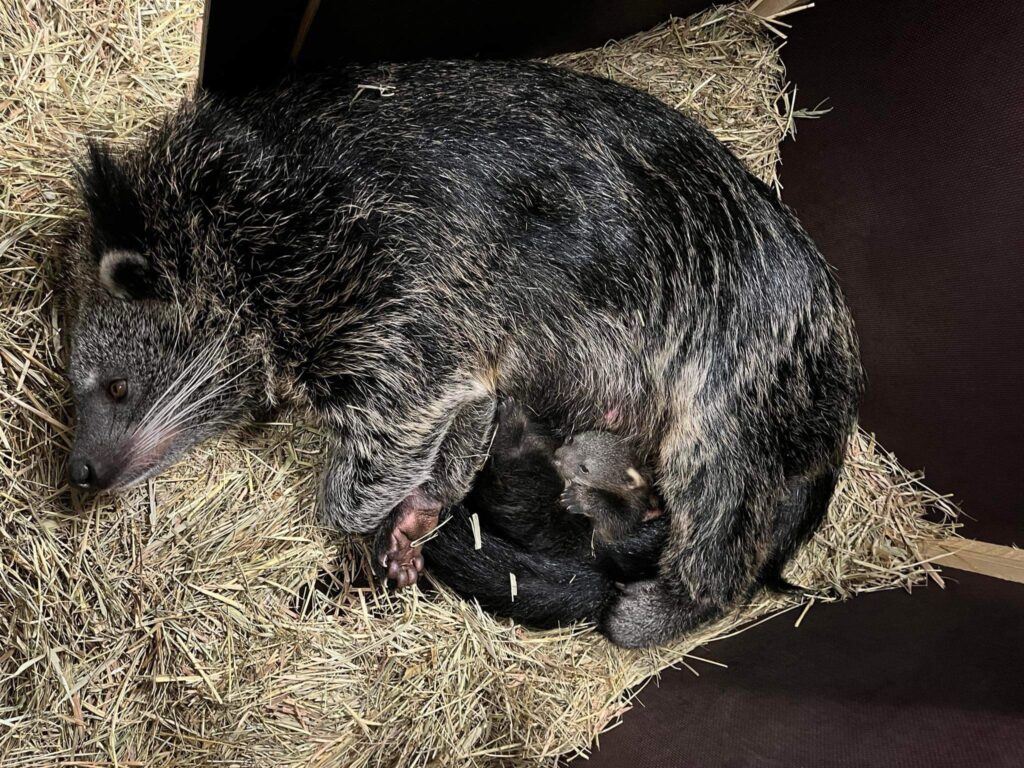This is the first cub born to the binturongs, Kawan and Pichaï, who are living in the Southeast Asian Rainforest exposition. Binturongs have been part of the Tallinn Zoo’s collection before, but the birth of a cub is a first.
Two-year-old Kawan and soon-to-be three year old Pichaï met at the Southeast Asian Rainforest Exposition in the spring of 2023. aasta kevadel. This winter, the behaviour of the animals gave hope that an addition to their family could be expected. An ultrasound scan performed on Pichaï, in February, confirmed the hope, and on 28 February, Pichaï began to give birth. The first cub was unfortunately stillborn – when giving birth for the first time, the birth canal may not open quickly enough or be wide enough, which could have been the cause of the complication.
An hour after the birth of the first cub, the second cub, whom the mother immediately began to care for, saw the light of day – she licked the cub clean and kept it next to her. At first glance, the constant vocalisations by the cub were a cause for concern. Veterinarians, curators and stewards suspected that the mother did not have enough milk to feed her cub. By mutual agreement of the zookeepers, it was decided not to completely separate the cub from the mother. When the mother briefly left the nest box, the attendants nurtured the cub with a special energy mixture. Mother and cub remained under round-the-clock surveillance. By the next day, the mother had already begun to produce enough milk, the cub no longer vocalised non-stop and was in its mother’s embrace.
At this time, both mother and cub are doing well. The cub is growing vigorously, its eyes have already opened, and it’s holding its head up. Occasionally, it grumbles and growls. Newborn’s mother Pichaï has also gotten used to her new role, having become a wonderful and very caring mother. At the end of March, the first veterinary examination will be performed on the cub, during which time the sex of the cub will also be established.
The binturong, also called a bear cat in many languages, gives the impression of being a cross between these two animals with its physique and manner of movement. Due to its long coat of fur and calm pace of life, it also resembles a sloth. While it walks slowly with clumsy steps on the ground, the binturong is a surprisingly adept climber despite its stout body. It has a prehensile tail, which it uses as a fifth limb, grasping tree branches with its muscular tip. When climbing down a tree trunk, the binturong is able to turn its hind paws outward so that the claws are capable of gripping even when descending head first.
The binturong spends at least half of the day napping in a tree. It may search for food both at night and during the day. The binturong is predominantly a frugivore, but also eats smaller animals if possible. A large part of its diet is made up of figs.
Generally, binturongs – who live a reclusive lifestyle – communicate with each other using scent markings. The smell of a binturong has been compared to that of popcorn. When communicating, binturongs also use a variety of vocalizations: hisses, snarls, grunts, and howls.
The binturong’s mother will remain in the nest box with her cub for a little while longer, which means that visitors will not be seeing them in the exhibition area for some time.






